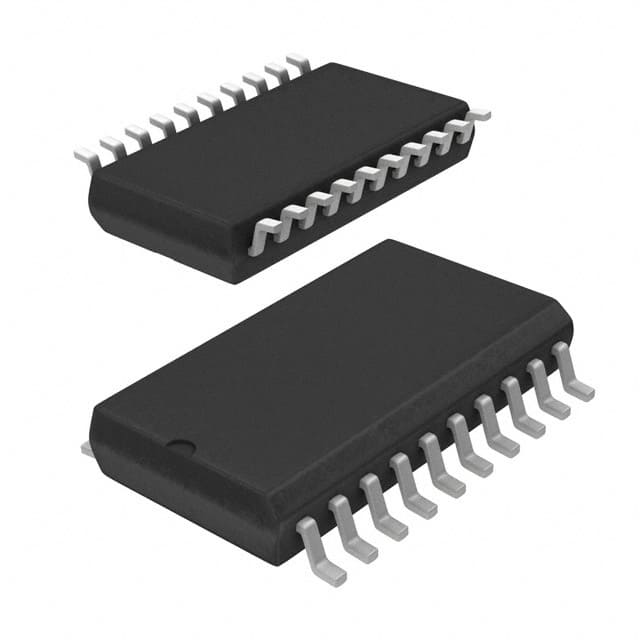Viz Specifikace pro podrobnosti o produktu.

SN74ABT620DWR
Product Overview
Category
SN74ABT620DWR belongs to the category of integrated circuits (ICs).
Use
This IC is commonly used as a bus transceiver. It facilitates bidirectional data transfer between two buses with different voltage levels.
Characteristics
- High-speed operation: SN74ABT620DWR operates at high speeds, making it suitable for applications requiring fast data transfer.
- Voltage level translation: It can translate signals between different voltage levels, allowing compatibility between buses operating at different voltages.
- Bidirectional communication: The IC enables data transmission in both directions, simplifying the design of systems requiring bidirectional data flow.
Package
SN74ABT620DWR is available in a small outline integrated circuit (SOIC) package. This package provides a compact and reliable form factor for easy integration into electronic systems.
Essence
The essence of SN74ABT620DWR lies in its ability to facilitate efficient and reliable bidirectional data transfer between buses with different voltage levels.
Packaging/Quantity
SN74ABT620DWR is typically packaged in reels or tubes, containing a specific quantity of ICs per package. The exact packaging and quantity may vary depending on the supplier.
Specifications
- Supply voltage: 4.5V to 5.5V
- Operating temperature range: -40°C to 85°C
- Input/output voltage levels: Compatible with TTL and CMOS logic families
- Maximum data transfer rate: Up to XX Mbps
- Number of pins: 20
Detailed Pin Configuration
- A1: Bus A input/output 1
- A2: Bus A input/output 2
- A3: Bus A input/output 3
- A4: Bus A input/output 4
- A5: Bus A input/output 5
- A6: Bus A input/output 6
- A7: Bus A input/output 7
- GND: Ground
- OE*: Output enable (active low)
- DIR: Direction control
- B7: Bus B input/output 7
- B6: Bus B input/output 6
- B5: Bus B input/output 5
- B4: Bus B input/output 4
- B3: Bus B input/output 3
- B2: Bus B input/output 2
- B1: Bus B input/output 1
- VCC: Supply voltage
- NC: No connection
- GND: Ground
Functional Features
- Bidirectional data transfer: SN74ABT620DWR allows data to be transmitted in both directions between two buses.
- Voltage level translation: It can translate signals between different voltage levels, ensuring compatibility between buses operating at different voltages.
- Output enable control: The output enable pin (OE*) allows the user to enable or disable the data transmission.
- Direction control: The direction control pin (DIR) determines the direction of data flow between the two buses.
Advantages and Disadvantages
Advantages
- High-speed operation enables fast data transfer.
- Voltage level translation facilitates compatibility between different voltage-level buses.
- Bidirectional communication simplifies system design.
- Compact SOIC package allows for easy integration into electronic systems.
Disadvantages
- Limited number of input/output pins may restrict the complexity of bus configurations.
- Requires careful consideration of voltage compatibility to avoid signal degradation or damage.
Working Principles
SN74ABT620DWR operates based on a combination of voltage level translation and bidirectional data transfer principles. When the direction control pin (DIR) is set to a specific logic level, data can flow bidirectionally between the two buses. The voltage level translation circuitry ensures that signals are properly translated between the different voltage levels of the buses.
Detailed Application Field Plans
SN74ABT620DWR finds applications in various fields where bidirectional data transfer between buses with different voltage levels is required. Some potential application areas include:
- Industrial automation: Used for communication between control systems operating at different voltage levels.
- Automotive electronics: Facilitates data exchange between different subsystems within a vehicle.
- Telecommunications: Enables compatibility between communication interfaces with varying voltage requirements.
- Consumer electronics: Allows for seamless data transfer between devices operating at different voltage levels.
Detailed and Complete Alternative Models
- SN74ABT16245ADGGR
- SN74ABT2245DWR
- SN74ABT541BDWR
- SN74ABT573ADW
- SN74ABT652ADW
These alternative models offer similar functionality and characteristics to SN74ABT620DWR and can be considered as alternatives based on specific application requirements.
Seznam 10 běžných otázek a odpovědí souvisejících s aplikací SN74ABT620DWR v technických řešeních
Sure! Here are 10 common questions and answers related to the application of SN74ABT620DWR:
Question: What is SN74ABT620DWR?
Answer: SN74ABT620DWR is a type of integrated circuit (IC) commonly used as a bus transceiver in technical solutions.Question: What is the function of SN74ABT620DWR?
Answer: SN74ABT620DWR acts as a bidirectional buffer, allowing data to be transmitted in both directions on a bus.Question: What voltage levels does SN74ABT620DWR support?
Answer: SN74ABT620DWR supports voltage levels between 4.5V and 5.5V.Question: How many data lines can SN74ABT620DWR handle?
Answer: SN74ABT620DWR can handle up to 8 data lines.Question: Can SN74ABT620DWR be used with different logic families?
Answer: Yes, SN74ABT620DWR is compatible with various logic families such as TTL, CMOS, and LVTTL.Question: Does SN74ABT620DWR have any built-in protection features?
Answer: Yes, SN74ABT620DWR has built-in ESD (electrostatic discharge) protection to prevent damage from static electricity.Question: What is the maximum data transfer rate supported by SN74ABT620DWR?
Answer: SN74ABT620DWR can support data transfer rates up to 200 MHz.Question: Can SN74ABT620DWR be used in high-speed applications?
Answer: Yes, SN74ABT620DWR is designed for high-speed applications and can handle fast data transmission.Question: Are there any special considerations for PCB layout when using SN74ABT620DWR?
Answer: It is recommended to follow the manufacturer's guidelines for PCB layout, including proper decoupling and signal integrity practices.Question: Can SN74ABT620DWR be used in automotive applications?
Answer: Yes, SN74ABT620DWR is suitable for automotive applications as it meets the necessary standards and specifications.
Please note that these answers are general and may vary depending on specific application requirements.

